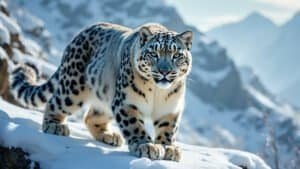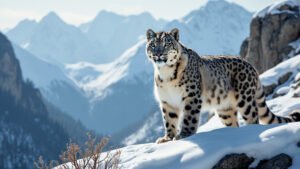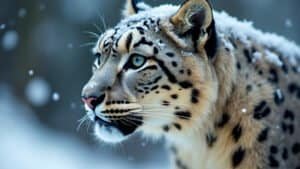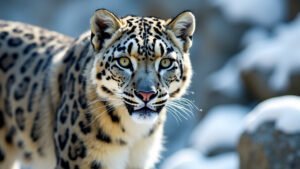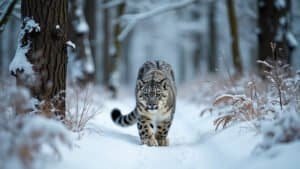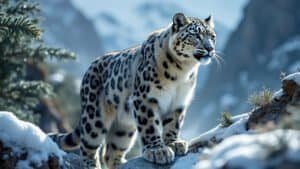Introduction
Snow leopards, renowned for their elusive nature and stunning appearance, possess unique genetic traits that distinguish them from other big cats
This article explores the key genetic differences that set snow leopards apart, focusing on their unique genes, physical adaptations, behavioral impacts, and reproductive biology
Additionally, we will delve into the conservation implications of these genetic distinctions, providing a comprehensive understanding of how these magnificent creatures have evolved to thrive in their harsh mountainous environments
Genetic Traits Unique to Snow Leopards
Snow leopards have evolved distinct genetic traits that enable them to survive in the harsh environments of the high-altitude mountain ranges they call home. Understanding these unique genetic characteristics helps researchers and conservationists protect these majestic animals
Key Genes Identified in Snow Leopards
Research into the genetic makeup of snow leopards has revealed several key genes that contribute to their unique adaptations. One significant discovery is the EPAS1 gene, which is associated with hypoxia tolerance
This gene allows snow leopards to efficiently use oxygen in low-oxygen environments, such as the high altitudes of the Himalayas and other mountainous regions. This adaptation is crucial for their survival, as it enables them to live and hunt at elevations where oxygen levels are significantly lower than at sea level
Another important gene is the PPARA gene, which plays a role in lipid metabolism. This gene helps snow leopards utilize fat for energy, providing them with the necessary stamina to traverse their rugged terrain and endure long periods without food. The adaptations in these genes are not found in the same form in other big cats, highlighting the unique evolutionary path of snow leopards
Evolutionary Pathways and Adaptations
Snow leopards have followed a distinct evolutionary pathway compared to other big cats
Their divergence from other Panthera species, such as tigers, lions, and leopards, is estimated to have occurred around 4.63 million years ago. This divergence has led to the development of several unique traits that are genetically encoded in snow leopards
One of the most notable evolutionary adaptations is their thick fur, which provides insulation against the cold temperatures of their habitat. The gene responsible for this dense fur is thought to be linked to a mutation that promotes the growth of longer guard hairs and a dense undercoat
Additionally, snow leopards possess large nasal cavities and well-developed lungs, which are adaptations to the thin air of high altitudes
Genetic Markers and Their Significance
Genetic markers are segments of DNA that can be used to identify and study genetic variations within a species
In snow leopards, several genetic markers have been identified that are specific to the species. These markers are used in genetic studies to track population genetics, understand genetic diversity, and identify potential threats to their genetic health
One such marker is the mitochondrial DNA (mtDNA) haplotype, which provides insights into the maternal lineage and evolutionary history of snow leopards
Studies have shown that snow leopards have a relatively low level of mtDNA diversity, which could be a result of historical population bottlenecks. This low diversity makes the species more vulnerable to genetic diseases and reduces their ability to adapt to environmental changes
Another significant genetic marker is the microsatellite DNA, which consists of repeating sequences of DNA. Microsatellite analysis has been used to assess the genetic diversity of snow leopard populations across their range
These studies have revealed that while some populations maintain high genetic diversity, others are at risk of inbreeding and genetic drift, which can negatively impact their long-term survival
Physical Adaptations from Genetic Differences
Snow leopards have evolved several physical adaptations that are directly influenced by their unique genetic makeup. These adaptations enable them to thrive in the extreme conditions of their high-altitude habitats
Fur and Skin Adaptations
The fur of a snow leopard is one of its most distinctive features. This thick, dense coat is an essential adaptation for survival in cold, mountainous regions. The genes responsible for the snow leopard’s fur include those that control hair growth, density, and coloration
The long guard hairs provide a waterproof layer, while the dense underfur offers insulation against the frigid temperatures. The light coloration with rosettes and spots helps them blend into the rocky and snowy environment, providing camouflage from prey and predators
Research indicates that these fur characteristics are linked to specific genetic variations. The ASIP (agouti signaling protein) gene and the MC1R (melanocortin 1 receptor) gene are known to play roles in determining fur color and pattern
Variations in these genes result in the unique pelage of the snow leopard, which differs from the fur patterns of other big cats like tigers or leopards
Muscle and Skeletal Structure
The muscle and skeletal structure of snow leopards have evolved to support their lifestyle in rugged terrain
Genetic studies have identified several genes that contribute to the development of strong limb muscles and a robust skeletal framework. These adaptations are crucial for climbing steep slopes, leaping across rocky outcrops, and ambushing prey in mountainous environments
One key adaptation is the enlarged nasal cavity and well-developed chest, which are adaptations for breathing in low-oxygen environments. The genes responsible for these traits ensure that snow leopards can efficiently take in oxygen, even at high altitudes where the air is thin
Additionally, the strong hind limbs, supported by specific muscle-related genes, provide the power needed for their impressive leaps, which can span up to 50 feet
Cold Climate Survival Mechanisms
Snow leopards have several genetic adaptations that help them survive in cold climates. These include metabolic adaptations that allow them to maintain body heat and energy levels
The UCP1 (uncoupling protein 1) gene, which is involved in thermogenesis, helps snow leopards generate heat without shivering. This process, known as non-shivering thermogenesis, is vital for maintaining body temperature in freezing conditions
Another critical adaptation is the thick, furry tail, which snow leopards use as a blanket to cover their faces while resting
The genetic basis for this trait includes genes that control tail length and fur density. The tail also aids in balance when navigating through their rocky habitat, which is another adaptation driven by genetic factors
Behavioral Impact of Genetic Differences
The genetic makeup of snow leopards not only influences their physical traits but also their behavior. These behavioral adaptations are crucial for their survival in the harsh environments they inhabit
Hunting Techniques and Strategies
Snow leopards have developed unique hunting techniques that are a direct result of their genetic adaptations. Their solitary and elusive nature is partly influenced by their genetic makeup, which drives their behavior to hunt alone rather than in groups, unlike lions
Genetic studies have shown that the genes related to olfactory receptors are highly developed in snow leopards, enhancing their sense of smell, which is essential for detecting prey in their vast and rugged territories
Their hunting strategy typically involves stealth and ambush, leveraging their camouflaged fur to blend into the rocky terrain. They are known to stalk their prey from above, using the element of surprise to their advantage
The genetic predisposition for strong hind leg muscles enables them to make powerful leaps, which are crucial for capturing prey in a single, swift attack
Reproductive Behaviors
Reproductive behavior in snow leopards is also influenced by their genetic makeup. Unlike many other big cats, snow leopards have a relatively short breeding season, typically from January to March
This seasonality is genetically driven and ensures that cubs are born during the warmer months of the year, increasing their chances of survival
Genes related to hormonal cycles play a significant role in this reproductive timing. The FSH (follicle-stimulating hormone) and LH (luteinizing hormone) genes regulate the reproductive cycle, ensuring that females are in estrus at the optimal time for mating
Additionally, snow leopards have genetic adaptations that support their solitary nature during the breeding season. Males and females come together only briefly to mate, after which the males leave, and the females raise the cubs alone
Social Structure and Solitary Habits
The solitary nature of snow leopards is a significant behavioral trait influenced by their genetics
Unlike lions, which are social animals living in prides, snow leopards are solitary and territorial. This behavior minimizes competition for resources in their sparse habitats and reduces the risk of disease transmission
Genetic factors that influence this solitary behavior include genes associated with territoriality and aggression. The AVPR1A (arginine vasopressin receptor 1A) gene, which is linked to social behavior in many species, shows variations in snow leopards that promote solitary habits
This gene influences behaviors such as scent marking and territory defense, which are crucial for maintaining individual territories
Additionally, the genetic basis for reduced social interaction is linked to lower levels of oxytocin, a hormone associated with social bonding. This genetic adaptation supports their solitary lifestyle, which is essential for survival in environments where prey is scarce and widely dispersed
Genetic Impact on Reproductive Biology
The reproductive biology of snow leopards is intricately linked to their genetic makeup, influencing their breeding patterns, genetic health, and offspring development. These genetic factors are crucial for understanding their reproductive strategies and ensuring the survival of the species
Mating Patterns and Success Rates
Snow leopards have specific genetic adaptations that influence their mating patterns and success rates. The genes regulating hormonal cycles play a significant role in determining the timing and frequency of mating
The synchronization of estrus cycles in females is crucial for successful reproduction, ensuring that mating occurs during a period when environmental conditions are favorable for raising cubs
Genetic studies have shown that snow leopards have lower genetic diversity compared to other big cats, which can affect mating success rates. Inbreeding depression, a consequence of low genetic diversity, can lead to reduced fertility and lower cub survival rates
Conservation efforts often focus on increasing genetic diversity through managed breeding programs to mitigate these risks
Genetic Health and Diversity
The genetic health of snow leopards is a critical factor in their overall reproductive success. Genetic diversity is essential for maintaining healthy populations, as it reduces the risk of genetic diseases and enhances the species’ ability to adapt to environmental changes. However, many snow leopard populations suffer from low genetic diversity due to habitat fragmentation and small population sizes
Efforts to assess and enhance genetic diversity involve genetic monitoring and the use of genetic markers to track population genetics
Programs such as captive breeding and genetic rescue, where individuals from different populations are introduced to increase genetic diversity, are vital for the long-term survival of snow leopards. These strategies help prevent inbreeding and promote healthier, more resilient populations
Offspring Development and Survival
The development and survival of snow leopard cubs are heavily influenced by their genetic makeup
Genetic factors determine traits such as immune system strength, growth rates, and behavioral adaptations. Cubs inherit a combination of genetic traits from both parents, which can affect their ability to survive in harsh environments
Studies have shown that genetic diversity within a litter can influence cub survival rates. Litters with higher genetic variation tend to have better survival outcomes, as diverse genetic traits can provide a broader range of adaptations
For instance, genetic variations that enhance immune function can protect cubs from diseases, while traits that improve physical development can aid in their ability to hunt and navigate their environment
Additionally, maternal genes play a significant role in cub development. Genes associated with maternal care behaviors, such as nurturing and protection, are crucial for the survival of young cubs
Snow leopard mothers exhibit strong protective instincts, often moving their cubs to different dens to avoid predators and environmental hazards. These behaviors are genetically influenced and critical for ensuring the survival of the next generation
Conservation Implications of Genetic Differences
The unique genetic characteristics of snow leopards have significant implications for their conservation. Understanding these genetic differences is crucial for developing effective strategies to protect and preserve this endangered species
Genetic Diversity and Population Health
Genetic diversity is a key factor in the overall health and resilience of snow leopard populations. Low genetic diversity can lead to inbreeding, which increases the risk of genetic disorders and reduces the ability of populations to adapt to environmental changes
Conservationists use genetic studies to monitor the genetic diversity of snow leopard populations, identify at-risk groups, and implement strategies to enhance genetic health
One approach is genetic rescue, where individuals from different populations are introduced to increase genetic diversity. This method helps to reduce inbreeding and promote healthier, more resilient populations
For instance, genetic studies have revealed that some isolated populations of snow leopards have very low genetic diversity, making them more vulnerable to diseases and environmental changes. By introducing new genetic material through managed breeding programs, conservationists can enhance the genetic health of these populations
Breeding Programs and Genetic Management
Breeding programs in captivity and in the wild play a crucial role in snow leopard conservation. These programs aim to maintain genetic diversity and support population growth
Captive breeding programs, such as those managed by zoos and wildlife sanctuaries, use genetic data to pair individuals that maximize genetic diversity. This careful genetic management helps to produce healthy offspring and reduce the risk of genetic diseases
In the wild, conservationists implement genetic management strategies to monitor and support natural breeding processes. This includes habitat protection, creating wildlife corridors to connect isolated populations, and mitigating human-wildlife conflicts
Genetic studies are used to track the success of these efforts and adapt strategies as needed
Future Research and Conservation Strategies
Ongoing genetic research is essential for the future of snow leopard conservation. Advances in genetic technologies, such as genome sequencing and genetic markers, provide deeper insights into the genetic makeup of snow leopards and their evolutionary history. These technologies enable researchers to identify critical genetic traits that are essential for survival and adaptation
Future research will likely focus on understanding the genetic basis of disease resistance, reproductive success, and behavioral adaptations
This knowledge can inform targeted conservation strategies that address specific genetic challenges faced by snow leopards. For example, identifying genes associated with disease resistance can help develop health management plans that reduce the impact of infectious diseases on snow leopard populations
Additionally, community-based conservation programs are vital for the success of genetic conservation strategies
Engaging local communities in conservation efforts ensures that habitat protection and anti-poaching measures are effectively implemented. Education and awareness campaigns can also help reduce human-wildlife conflicts and promote coexistence
Conclusion
The genetic differences between snow leopards and other big cats are key to their survival in the rugged, high-altitude environments they inhabit
These differences encompass unique genes that support physical adaptations, such as thick fur and strong muscles, and behavioral traits like solitary hunting and seasonal breeding. Understanding these genetic distinctions is crucial for developing effective conservation strategies
Efforts to preserve snow leopards must focus on maintaining and enhancing genetic diversity to ensure population health and resilience. This includes genetic monitoring, managed breeding programs, and habitat protection
Ongoing research into the genetic basis of snow leopard traits will continue to provide valuable insights, enabling conservationists to address specific challenges and promote the long-term survival of this magnificent species. By integrating genetic research with practical conservation measures and engaging local communities, we can ensure that snow leopards thrive in their natural habitats for generations to come


